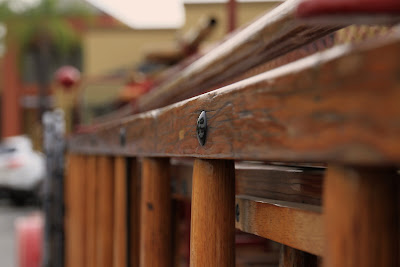Most agencies have a parade unit, either an antique unit that has been restored or a vintage unit that has outlived it's usefulness but is unique or well preserved. Usually, they are fire engines as opposed to ladder trucks, squads or other vehicle. Every once in a while, you mights see a jeep or a chief's buggy that has been restored.
I ran into a vintage ladder truck the other day, this one a Seagrave. It was at a St. Patrick's day fundraiser and as it had just arrived, they were spiffing it up as we walked by. I didn't get any info on it, but I believe it may be a "City Service Truck", as it did not have an aerial ladder.
Of course, I had to take some photos. (click to enlarge)
As the lighting was off and the venue not to my liking, I focused on detail.
You don't see these life nets much anymore, and if you do, they are usually hanging on a wall. Engines didn't have the room, so they were carried on truck companies. I don't think anybody uses them, they don't have the staffing and don't want the liability. Like the pompier ladder, the life net is now a museum piece.
A well full of ladders, all wood.
Wooden ladders down both side of this truck as well. Look at the grain on the rung of this ladder, it is beautiful wood.
This is something that I have never seen before, a wooden folding attic ladder. It folds just like the aluminum attic ladders that we use, it just happens to be made of wood. Again, beautiful grain and texture.
If any of you happen to work for an agency that uses wooden ladders, are your attic ladders wooden as well?
I was fortunate to be able to run across this truck, it was quite photogenic. If I ever find out any details on it, I'll pass them along. Hope you all are enjoying your weekend, I am back at work, but enjoyed my break.
Thanks for reading,
Schmoe
Saturday, March 19, 2011
Subscribe to:
Post Comments (Atom)







Those are beautiful!! Thanks for sharing them Capt!
ReplyDelete911R
Nice shots, Capt. You're right, I rarely see preserved ladder rigs. City Service Trucks are even more rare.
ReplyDeletePart of it may be due to the extra size requirements -- garaging an old engine is much easier. Also, in my part of the country many city ladders retire to the suburbs and live second or third lives. By the time they are finally retired, there isn't much left to preserve.
That's an exceptional rig. It shares its chrome grille, Moto-meter, and seat and gas tank styling cues with our 1930 Seagrave Suburbanite 6DWT 750gpm pumper, so I suspect it hails from within a year or two of that. Ours was restored as a parade rig the year before last. Our wooden ladders are similar to those, though we don't have an attic ladder - THAT is neat. Our polyurethane job on the ladders didn't come out quite as nice as those - but it's close, by which I'm gratified. But we may sand them lightly this year and put on another coat to see if we can make them look nicer. Awesome photos. :)
ReplyDeleteNot to be argumentative, but it is impossible, to my knowledge, to have a Suburbanite 750gpm, the suburbanite had either a 350 or 500 gpm pump and that was the principle difference between it and the Standard series, which were all 750 or 900, with the Metropolite being the larger 1300gpm. Also your model number is that of a standard, the 6 for 6 cylinder engine, the D for 4 wheel disc brakes, W for worm gear drive (instead of chain drive), and T for pumper (and no i dont know why t is for pumper either). I own 1925 6WT (the disc brakes came in 1927 if memory serves)The other principle difference is the motor, the suburbanite used a flat-head 6cyl made by Contential while all the standards used the seagrave T-head 6 cyl.
DeleteHey Mike, I have a 1926 Suburbanite that was originally delivered to a small township in Maine. I still have all of the original build sheets on the truck. Mine was supplied with a 400 GPM rated pump. Just to let you know. Jim
DeleteDifferent GPM Rating
Delete911R - Thanks for the comment, I am glad you liked them. The kids (20&18) played hooky and we went out for breakfast, this truck was on display at the restaurant. A fundraiser sort of thing. I had #2 son hold my camera bag as we shot the truck. Afterward, we went to the show. The saint I Am Married To was stuck at work while we goofed off all day. A great day (for us!)
ReplyDeleteMack 505 - I think this is the only City Service truck that I have seen outside of a museum. Though not perfect, it is obviously well cared for, a rare gem for sure.
NYEMT - It looked kind of '30s to me as well. Funny, I look at those wooden ladders, all I see is work! I am glad that these were taken care of, they are beautiful.
Thanks for the comments, glad you liked the pics.
Great pics Cap.
ReplyDeleteNow if you don't mind another lesson on the fire service.....
I'm guessing that a City Service Truck would be a variant of the Aerial Ladder intended for use in areas with very dense construction where you wouldn't have the room to raise and swing a turntable mounted ladder?
Such as the multi-story tenement neighborhoods seen in larger cities during the late 1800s and early 1900s?
Thanks Cap,
BGM
San Francisco utilizes wooden ladders. I wonder if there attic access ladders are composed of wood as well?
ReplyDeleteWhat was the purpose of the life nets?
BG - Actually, room isn't usually an issue, though it can be. My guess is that depts. that didn't have buildings over three stories but wanted a unit that had a full NFPA compliment of ground ladders could buy a City Service Truck. Insurance grading companies would give full credit as if it were an aerial ladder truck but the dept. was spared the considerable expense of an aerial.
ReplyDeleteI once knew a fire chief who turned an old pumper into a "City Service Truck" just prior to an ISO grading. That, and other questionable items earned the dept. a rating of 3. Shortly after the grading, the City Service truck was retired and not replaced. I still can't believe ISO bought off on it.
Thanks for the comments.
B_Sheehan - The life net was just that. 8 or 10 firefighters would open it up and hold on to it under a window. They would hold it palms up and then have people jump into it, usually to escape a burning building. Occasionally they would deploy it under jumpers. I think it was only good for a few stories, I don't know anyone who ever used them.
ReplyDeleteThanks for the question.
I love the grain on that wood. Beautiful.
ReplyDelete"Attic ladder" is new to me. A post on the different types of ladders and their uses might be fun, if you want.
Cap,
ReplyDeleteI know LA City uses wooden ladders as well, though I'm not sure of their attic ladders... I completely agree, it looks like a lot of work. San Fran has a city/public works shop just for their ladders, and I think LA does most of their maintenance in-house at the station.
Beautiful shots; your photography is always inspiring and enjoyable.
Thanks, as always, for sharing.
Thanks again for the kind words - Schmoe
ReplyDelete